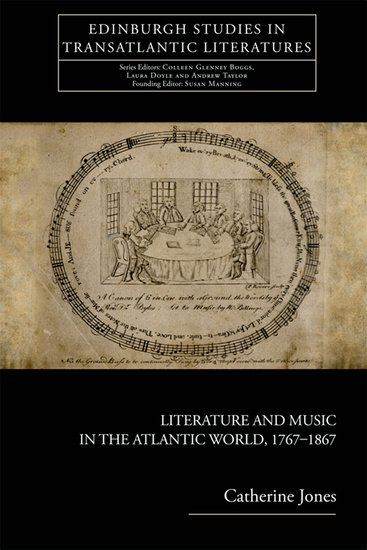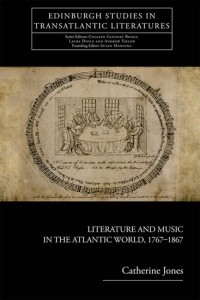The Canon between Arts and Nations

Literature and Music in the Atlantic World, 1767–1867 presents an interdisciplinary account of a rich period in the history of Western culture. Considering figures as diverse as Johann Sebastian Bach, Thomas Jefferson, Ludwig van Beethoven, and Frederick Douglass, Catherine Jones weaves together a patchwork of case studies in the transmaritime interaction of two major art forms over the course of a century. The thread uniting her examples is the connection of rhetoric to music. She shows how this relationship, in its reliance on European culture, evolved from the American Revolution through the Civil War. A common conception is that the rhetorical model of music languished with the triumph of absolute music in the nineteenth century, but Jones argues that music led a rhetorical life in the Romantic era by virtue of its connection to national identities and to literary theories of organicism and the sublime. Her transatlantic approach also contests the centrality of the nation in accounts of artistic production, and her interdisciplinarity challenges the autonomy of literature and music as fields of historical study.
In fewer than two hundred pages, Jones traverses a wide territory. The chapters move from the American reception of Charles Burney’s history of music in her introduction, for example, to the significance of European musical thought for leaders of the American Revolution (chapter one), to the role of music in Thomas Jefferson’s foreign correspondence (chapter two), to the reception of Beethoven among New England Transcendentalists (chapter three), to connections between Thomas Moore’s and Frederick Douglass’s attitudes toward music (chapter four), and finally to the legacy of J.S. Bach in American music criticism (chapter five). Her discussion is meticulously sourced, and the academically inclined will spend as much time perusing her detailed endnotes as they will her concise narrative. As a scholar of literature, Jones is at her best when analyzing the written word. Her account of how the concept of the musical sublime came to be transmitted from German thinkers like Christian Friedrich Michaelis and Friedrich Gustav Schilling to the American John Sullivan Dwight, for example, is robust and nuanced. Jones’s comparative lack of training in music is sometimes evident—for example, her discussion of Paul Revere’s music-notational frontispiece to William Billings’s New-England Psalm-Singer (1770) contains inaccuracies—but non-specialists will still find this book useful for its introduction to musicology, including the work of noted scholars like Carolyn Abbate and Carl Dahlhaus.
One of Jones’s achievements is that she offers fresh approaches to familiar subjects like Beethoven, Franklin, and Walt Whitman.
At its best, Literature and Music unveils intriguing transnational connections between major authors and composers that open broad new avenues of inquiry. Who knew, for example, that Benjamin Franklin penned a critique of the relationship between words and melody in an aria from George Frideric Handel’s oratorio Judas Maccabeus (1747), and that this analysis reflects Franklin’s sustained engagement with European debates in musical aesthetics? Citing musical examples in a letter to his brother, Franklin rebuked Handel for distorting the properties of natural speech, and thus obscuring the message of the aria, by a characteristically Baroque excess of musical artifice. Franklin’s advocacy of a plainer, more agreeable musical style reflected his investment in political notions of transparency and consent. For Jones, Franklin’s musical thought, together with the transmission to America of the Orpheus legend, which mythologized music’s persuasive power, documents a belief that music could improve society. Leaders like Franklin and Jefferson certainly prized music for its rhetorical force, but perhaps the more interesting point here, which Jones doesn’t quite make, is the isomorphism between American republicanism and the European fashion for galant music, which opposed the Baroque by virtue of its pleasing simplicity.
One of the highlights in Jones’s account of the Romantic era is her revelation of Washington Irving’s contribution while in Europe to the first English translation of Carl Maria von Weber’s opera Der Freischütz (1821), and of the consequences of this for the composer’s reception first in London and then as far afield as New York and New Orleans. Irving and his collaborator, Barham Livius, grappled with the same problems that make the transmission of opera a fascinating subject today, including the need to alter stories in light of changing political context, the obligation to consider local theatrical taste, and the difficulty of reconciling new words to existing music, which can result in changes to the score. In detailing differences between German, British, and Anglo-American versions of Der Freischütz, not to mention French adaptations mounted in Paris, New Orleans, and Philadelphia, Jones shows how a single opera could mediate multiple national and cosmopolitan identities. Assigning special importance to New Orleans, she argues that it acted as a hub for the transmission of continental European music to the rest of the United States. Her conclusions ought to inspire contextual studies of other important operas—for example, Wolfgang Amadeus Mozart’s Don Giovanni (1787), Giacomo Meyerbeer’s Robert le diable (1831) and Gaetano Donizetti’s Anna Bolena (1830) and Lucia di Lammermoor (1835)—that appeared in translated adaptations on American stages during the first half of the nineteenth century.
The transatlantic and transdisciplinary rationale of Jones’s project doubtless requires a broad perspective, but at times the vast scope of the book hinders its depth and flow. The number and variety of case studies necessitate an anecdotal approach, with the result that Jones’s larger interventions and individual analyses aren’t always fully developed. For example, her efforts to relate the writings of Emily Dickinson to the music of two rather different composers, J.S. Bach and Claude Debussy, lack the direct evidential links that underpin her other arguments. She goes to interpretive lengths to identify a vague Christological correspondence between Bach and Dickinson—one that needs to be mediated by the eighteenth-century theologian Jonathan Edwards and the nineteenth-century music critic J.S. Dwight—and she ascertains a similarly imprecise resemblance between Dickinson’s fragmentary poetic language and the aesthetic of interruption outlined by the twentieth-century philosopher Vladimir Jankélévitch in connection with Debussy’s music. These lines of investigation aren’t without interest, but they remain speculative. Non-sequiturs also creep in: the logic leading from, say, a 1939 review of Charles Ives’s Concord Sonata, to an 1849 speech by Frederick Douglass, is unclear. Lacking the cohesion and narrative integrity more easily attained in a more focused study, the book reads at times as a miscellany of musico-literary connections.
But this doesn’t mean that those connections aren’t interesting and important. One of Jones’s achievements is that she offers fresh approaches to familiar subjects like Beethoven, Franklin, and Walt Whitman. The drawback to her preoccupation with major personalities, however, is that she overlooks the work of lesser-known, pseudonymous, and anonymous authors, composers, editors, and copyists, who were essential to American cultural production in this era. Meredith McGill’s American Literature and the Culture of Reprinting, 1834–1853 (2003) showed the importance of piracy and its elusive agents in the transnational formation of antebellum literature, for example, and Jones would have done well to address this. More problematically, Jones’s fixation on the big names of history leads her to neglect a vital region of the Atlantic world—the Caribbean. For a more broadly Atlantic perspective on creative life, readers might consult Elizabeth Dillon’s New World Drama: The Performative Commons in the Atlantic World, 1649–1849 (2014). Although Jones excludes part of the Atlantic world and gives relatively short shrift to the workaday intermediaries responsible for the material transmission of literature and music between continents, the list of those who will benefit from reading her book is long. She contributes to the scholarly literature on dozens of canonical figures in an accessible manner. And if her treatment of individual cases risks, at times, being superficial, this is excusable, because the chief value of Literature and Music is as an impetus to further study. The book offers a rich catalogue of international artistic relationships that invite additional research.
This article originally appeared in issue 16.1 (Fall, 2015).
Myron Gray teaches music history at Haverford College. He holds a PhD in musicology from the University of Pennsylvania and has published articles on the early American reception of French music in Common-place and American Music.
